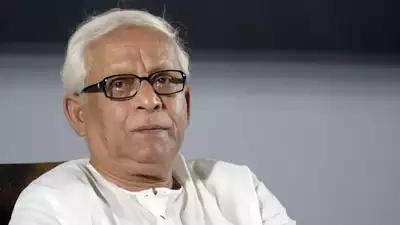Former West Bengal Chief Minister Buddhadeb Bhattacharjee (80) passed away on Thursday morning at his residence in Kolkata. He is survived by his wife, Mira, and daughter, Suchetana.
He was known as “reformist” Left, as Chief Minister who hoped to haul West Bengal into the industrialisation age with “the world’s cheapest car”. The writer-politician failed to take own party along, and the leader who ultimately fell to one almost completely unlike him.
The veteran CPI(M) leader became the Chief Minister of West Bengal in 2000, succeeding Jyoti Basu. His tenure saw significant political turbulence, including agitations over land acquisition for industrial projects led by the current Chief Minister, Mamata Banerjee. Bhattacharjee’s leadership ended with the CPI(M)-led Left Front’s 34-year rule in the state when they lost to Banerjee’s Trinamool Congress in the 2011 assembly election.
During his tenure, Bhattacharjee launched an industrialisation drive, including huge investments in IT and ITES (information technology enabled services) sectors, a plan to build the country’s largest integrated steel plant in Salboni, a chemical hub in Nayachar, an SEZ in Nandigram and the Nano plant in Singur.
The latter two, however, would prove Bhattacharjee’s undoing, as the acquisition of land in Singur, Hooghly district, for Tata Motors to build Nano in 2006, and for the SEZ in Nandigram in 2007, ran into huge protests from farmers.
Bhattacharjee started out as a primary member of the CPI(M) in 1966 and took an active part in the party’s food movement against the famine-like conditions under a Congress government. He later became state secretary of the Democratic Youth Federation, the CPI(M)’s youth wing, which later merged into the Democratic Youth Federation of India. He was elected to the state committee in 1972, and became a part of the state secretariat in 1982.
After winning his first Assembly election from the Cossipore-Belgachia seat, Bhattacharjee served as the Information and Public Relations Minister from 1977 to 1982.
After losing from the Cossipore seat in 1982, Bhattarcharjee moved to the Jadavpur Assembly constituency and won it from 1987 to 2011. In 1987, he was inducted as the Information and Culture Minister in the Jyoti Basu Cabinet. He resigned in 1993 over differences with Basu, but joined back after a few months.
In 1996, he became the Home Minister, and in 1999, with Basu ailing, he was named the Deputy CM. He took over as the CM for the first time on November 2, 2000, after Basu stepped down. In 2002, he was elected to the Politburo of the party.
Even as Bhattacharjee occupied the top position in the state, his wife Meera and daughter Suchetana lived in a two-room apartment in Ballygunge in Kolkata, the residence they continue to live in.

